Age group 1 4 to 6 years old
Body
"Sex markers" - biological classification of the sexes
Medicine and society use the following criteria for the body - people are divided into male and female by these so-called gender markers:
| . | . | |
|---|---|---|
| Genetics | XY chromosome set | XX chromosome set |
| Gonads | Testicles + Sperm | Ovaries + Egg cells |
| Internal sex organs | Prostate, Vas deferens | Fallopian tubes, Uterus, Vagina, Crus of the clitoris |
| External sex organs (genitals) | Penis, Scrotum + Testicles | Vulva = Tip of the clitoris, Labia, Mons pubis, Vaginal opening |
| Secondary sex characteristics | Beard, Voice, Musculature, Hair | Breast, esp. fat distribution |
| Hormones | Increased testosterone | Increased estrogen |
Prenatal sex development
The development of the sexes is the same for all children during the first five weeks of pregnancy. Only then do male and female embryos begin to develop differently. In a girl, the bulge between the legs gradually matures into the external sex organs: clitoris, labia majora and labia minora. In order to complete sexual development, the gonads must now form - ovaries and testicles. From the fifth week onwards, tissues grow in the body of a female embryo, which turn into the uterus, fallopian tubes and the upper part of the vagina. It is similar in a male embryo: here the epididymis, vas deferens and seminal vesicles form, and superfluous tissue regresses.
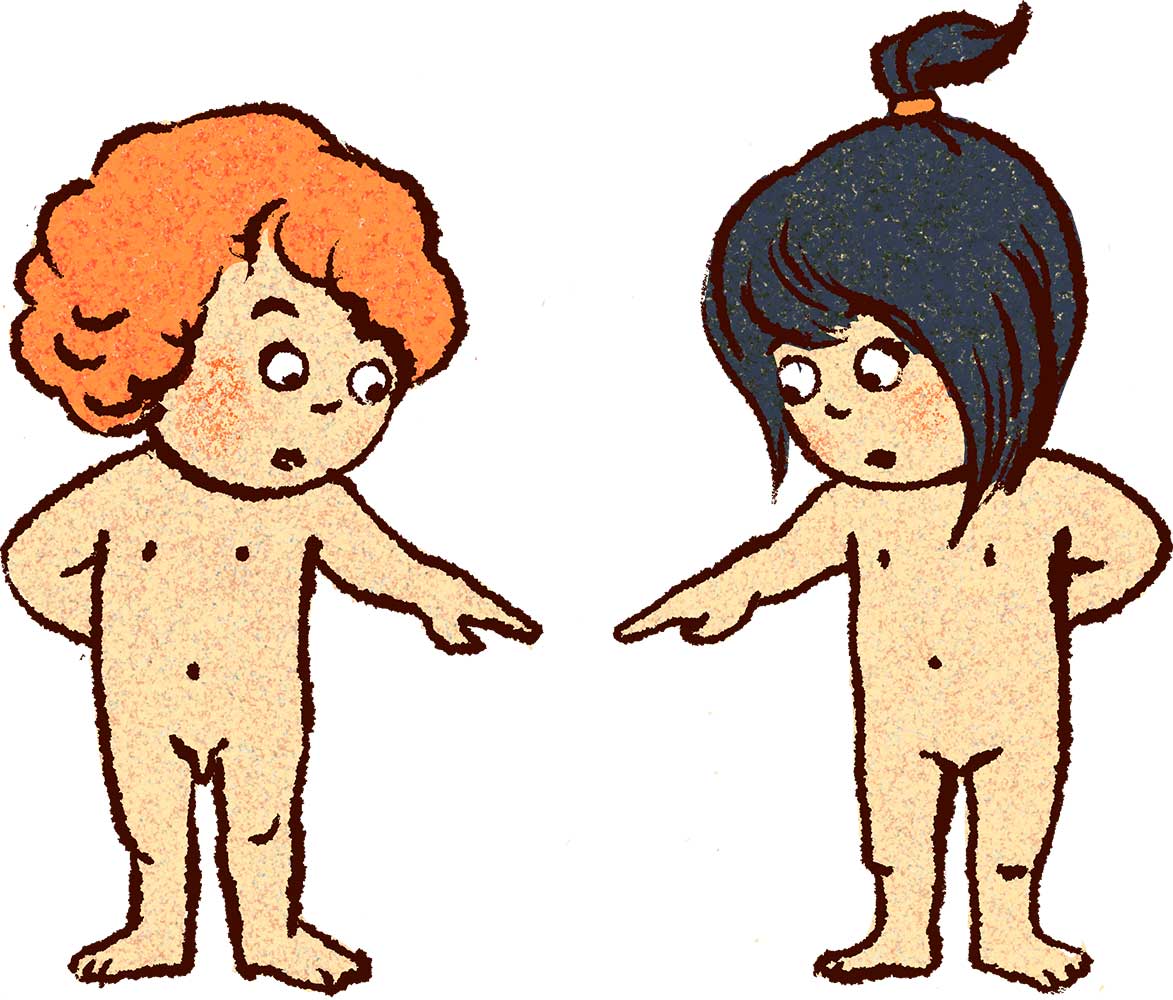
"What will it be?"
Even during pregnancy it is important for many parents to know "what it will be" - a girl or a boy. In about one to two out of 1000 children, they cannot be clearly assigned male or female due to their genitals (external sex organs) after birth. This is called intersexuality or variants of gender development.
Therefore, in reality, there are far more variations than the upper table in terms of sexual characteristics:
| Genetics | XX, XY, XXY, XXYY, XXXY |
| Gonads | Testicles + Sperm, Ovaries + Egg cells |
| Inner genitals | Vas deferens / Fallopian tubes, Uterus, Vagina, Prostate |
| External genitals | Penis/Clitoris/Phalloclitoris, Labia/Scrotum |
| Secondary sex characteristics | Body fat distribution, Beard growth, Breast, Voice, Musculature, Body hair |
| Hormones | Testosterone, Oestrogen |
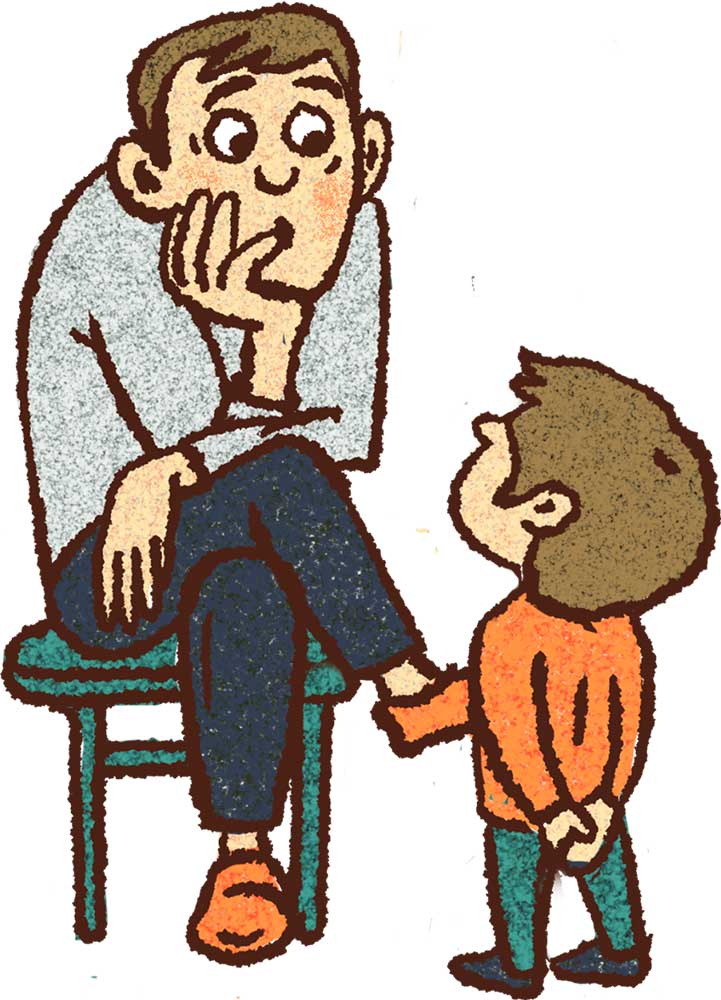
Young children and their bodies
Few people are aware that they are already engaged in "sexual education" during infancy - for example, by naming or not naming body parts. This is where the foundation is laid for a positive body image and a sensitive, positive approach to one's own later sexuality.
For most children with a penis, touching, tugging or rubbing it is completely natural. Children with vulvas often rub them on the edges of chairs or stuffed animals. This is age-appropriate. Children also like to use this kind of self-stimulation as a sleep aid/ritual. Many children in this age group stimulate themselves on their own genitals because this triggers "nice feelings". If a sense of shame has not yet set in, they may also do this in public - for example, in the morning circle of the kindergarten or at family celebrations.
What can you do?
Parents or educators who react to this with the words "if you are comfortable with that, then please do it in the room/cuddle corner etc." show the child that they are of course allowed to touch their body everywhere - but that there are rules and limits. Also protect your child from the stares of adults when he or she explores his or her body. If your child does this excessively, it could be due to a lack of alternative ways to relax, it could have organic causes or it could also be a sign that the child is feeling some kind of stress. Ask an educator or counsellor who knows about children's sexuality for a professional opinion.
First questions arise
In the following, we have compiled examples of typical children's questions and possible answers to them. You are welcome to use the answers written in green when talking to your children. The sentences written in black are an explanation for adult readers.
"What is the difference between girls and boys?"
"Most girls have a vulva, most boys have a penis and testicles".
This takes into account the fact that genitalia look different and includes intersex children. Children recognise the differences between the sexes even in infancy. They find this very exciting and want to "check" this again and again, for example by going to the toilet with each other. Terms of endearment or family words for the genitals are okay, but the children should also know the correct terms. In this age group, this concerns the terms for the external, that is, visible, sexual organs.
"Where do babies come out of?"
"When the baby is big enough, it comes out through the vagina after about 9 months."
When asked if this hurts, you could answer:
"It's very exhausting for the mother and the baby. But when it's there, you're so happy that it doesn't matter any more."
If your child was born by caesarean section, explain this in child-friendly terms, such as:
"Because you were not lying with your head down, I was given an anaesthetic, then my belly was opened up and you were lifted out. Afterwards, the stomach was sewn back up."
"How do babies get into your belly?"
"Most babies are made like this: when a man and a woman love each other very much, they kiss, they cuddle together, maybe naked, and the closest you can cuddle is when the penis enters the vagina. Then when they continue to cuddle, a lot of sperm comes out of the penis and when it meets an egg, a baby can be born."
EVERY question should be answered when it is asked. It does not have to be answered immediately, you can give yourself some time to think about it or read about it. But then you should approach the child and answer the question on your own.
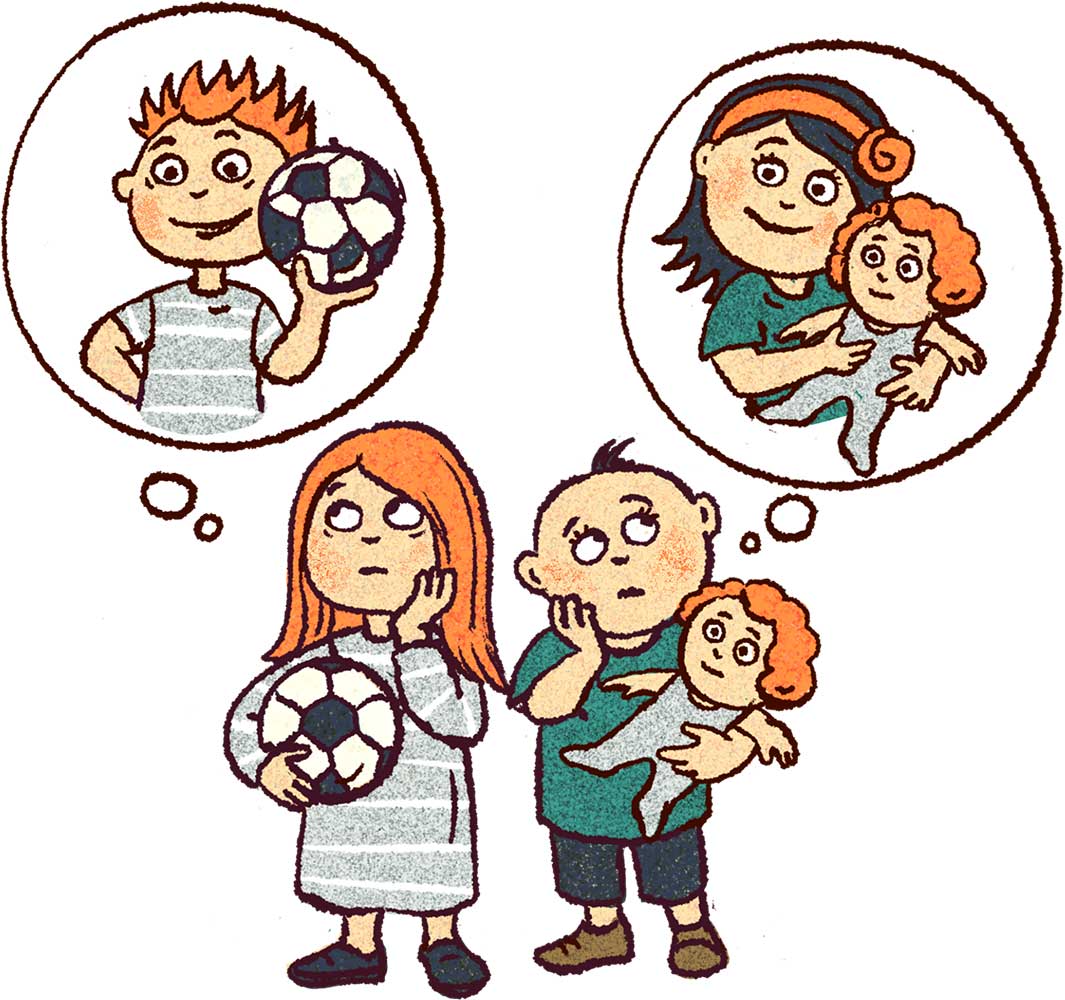
Identity
Every child has a sense of gender
Children realise very early on that gender and the expectations associated with it play a central role in their lives. Even before the age of 4, children classify themselves according to gender. They thus consciously perceive differences in their interactions with girls and boys. This has an influence on the development of their ego identity, the child's behaviour and their understanding and self-classification as a "real" girl or "real" boy. In developmental psychology, the term gender identity is used in this context.
Even at preschool age, children notice that there are differences in the behaviour and external characteristics of girls and boys. Parental affirmations and behaviours influence the development of gender identity and lead children to ask what makes a "real" boy or a "real" girl, what he/she plays with, what he/she wears, how he/she behaves. Girls, for example, notice when they are praised for their diligence and when they are asked about their appearance. Boys are similarly influenced when they are encouraged to act more wildly or are given the signal that crying is not masculine.
At around four years of age, this phase of observation is followed by a time when children begin to identify with their own gender. They begin to prefer persons from the same gender group, when playing, for example.
The idea of the "right" girl or boy changes throughout life in connection with one's own physical development and the information on the diversity of gender conveyed by the social environment.
Gender identity: My child is trans
Gender identity, in other words one's own perceived gender affiliation, is closely related to self-perception. It is developed in the brain and is not a conscious decision. According to Stephanie Brill and Rachel Pepper in a guidebook for parents, "People do not choose to feel like a boy or a girl or both or neither. They simply are who they are."
In some children, their gender identity does not match their body sex, that is, their anatomy. These children are trans.
Gender identity develops at the same time as language ability. Therefore, it is possible that your child will also communicate with you accordingly. Sentences such as: "Mummy, I'm not a boy, my penis will fall off soon anyway" or "I want Santa to give me a penis" may be uttered. Such statements can vary greatly in their meaning and frequency, but it is important that they are heard.
The transgender network in Switzerland advises parents to take plenty of time, listen carefully and continue to give parental love if they suspect that their child is trans. Parents who have organised themselves in the association Trakine e.V. in Germany clearly state: "For us, the needs of our children are in the foreground, which they express in the here and now. This includes first and foremost the recognition of their designated gender, their chosen gender expression and, if desired by the young person, the alignment of their physical appearance with their gender perception."
What can you do?
Take your child's expressions and appearance seriously and support them when meeting others. If you have questions about the topic, we recommend contacting Transgender Europe, as you can find information from the individual countries and contacts to initiatives in your country.
The children's book "I Am Jazz" was co-written by Jazz Jennings at the age of 14. She was born a biological boy and already knew at the age of two that she was trans. With the book, published in 2014, she wants to reassure children who feel the same way, as well as their parents (ISBN: 978-0803741072).
Children learn about social gender
Various studies show that we deal with girls and boys differently and often classify them stereotypically. This is not always a negative thing, but it should be questioned when dealing with preschool children. As a recent experiment by psychology professor Kristin Shutts in Madison shows, this age group is already influenced by gender perception. Three-year-old girls and boys saw on a monitor, one after the other, a girl and a boy who had an object with them that the children were not familiar with. The boy said: "My name is Ben. I like spudel. Spudel is my favourite food.", the girl: "My name is Betsy. I like Blickets. Blickets are my favourite food." Then the watching children were asked what they would prefer to eat. 65% of the boys chose spudel and 85% of the girls chose Blickets. They did not know the dishes and apparently based their decision on the gender of the children.
What does it actually mean to be a girl or a boy? Is the small difference innate or inherited? Research is not yet in agreement about this, but it is assumed that one half is determined by genetics and the other half by social influences. There is still a tendency for boys to be brought up differently than girls. Boys are thought to be tougher and stronger from an early age, to have scraped knees and not to complain about them. Girls are considered to be more communicative and therefore they are talked to earlier and more. This means that even preschool children are often unconsciously and quite naturally grouped and treated according to their gender. It would be better to treat children according to their preferences and talents, their abilities or their individual aptitudes. Even if you as a parent consciously try to offer girls and boys more diverse opportunities, you will probably experience that your daughters or sons behave in a gender stereotypical way. At the age of three to four, this is related to the development of the sense of gender and the self-discovery process associated with it. However, the older the children get, the more sensitively they react to attributions, for instance in their choice of clothes and toys, and refrain from objects or colours that seem to "belong" to the opposite sex.
What can you do?
Be a role model and do things with feminine and masculine connotations as a matter of course and without explanation (e.g. men can also iron and women can be good DIY enthusiasts). Provide guidance by answering questions early on, while keeping gender roles as open as possible. Let children experiment with gender roles. For example, when dressing up, avoid statements such as "Girls/boys don't wear that" and distribute tasks according to the children's individual abilities and interests.
Feelings
With sexual education from the very beginning, children learn the value of physical contact, intimacy and closeness and the well-being that is associated with them. Children learn to distinguish between pleasant and unpleasant feelings and between familiar and unfamiliar persons. This ability continues to develop as they grow older. As parents, you consciously and unconsciously convey messages about feelings and emotions through the way you react, speak and pay attention to various things. In this way, you consciously but also unconsciously provide sex education.
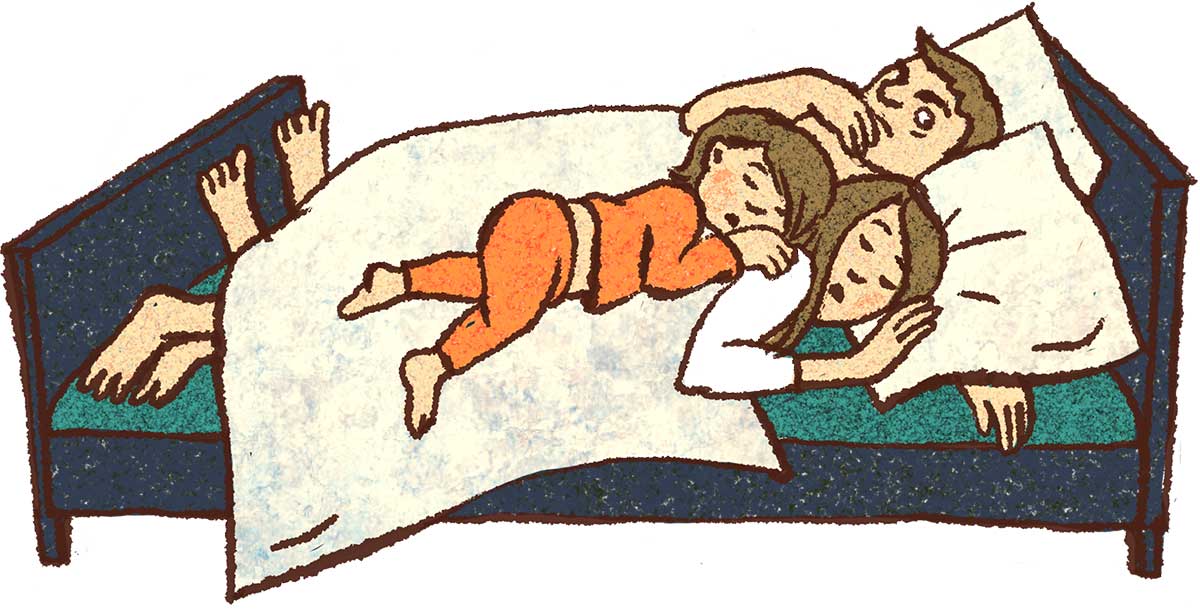
Children's feelings should always be respected. Even if you think this is inappropriate. Children know exactly when they are happy, who they want to play with or who their new boyfriend or girlfriend is.
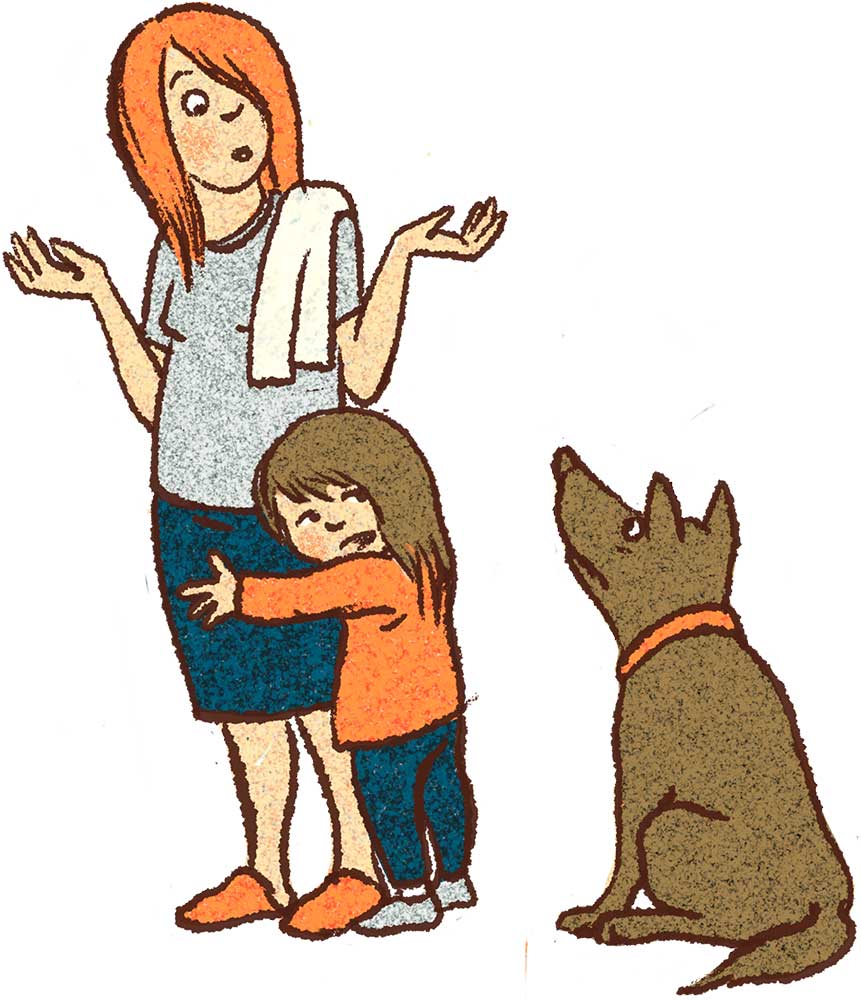
Bonding plays an important role
Between the ages of four and six, many children also discover their love for the opposite-sex parent or for someone familiar of the opposite sex; this can also begin as early as the age of three. It is not uncommon for parents to hear sentences like "When I grow up, I'll marry you!". This shows the child how significant the parent is and expresses their love. This feeling can develop into jealousy in children and they claim the parent only for themselves. This can express itself in contact with other children by saying "Go away, that's my mummy!". These intense feelings can also be so strong that your child no longer wants to leave your side and, for example, wants to sleep in bed with you every night. This behaviour of children towards parents can be uncomfortable, but it is important to know that the child does not behave this way intentionally.
This behaviour is an expression of the child's serious feelings of attachment and belonging. Make it clear to the child, in a loving and understanding attitude, that the relationship between you and the child will not be affected by your other relationships (friendship, other children who are friends, relationship partners). It can also happen that children choose another familiar person for their deep affection instead of a parent and shower them with tokens of love. Always be sensitive to ensure that no misunderstandings arise. Especially in this phase, closeness is enormously important for children. It is also important that children learn to set limits and have the right to say "no". Children should be empowered and encouraged in the development of their autonomy. For example, you can lovingly encourage your child to sleep in their own bed or to spend some time with another familiar person.
Children experience boundaries and their sense of shame develops
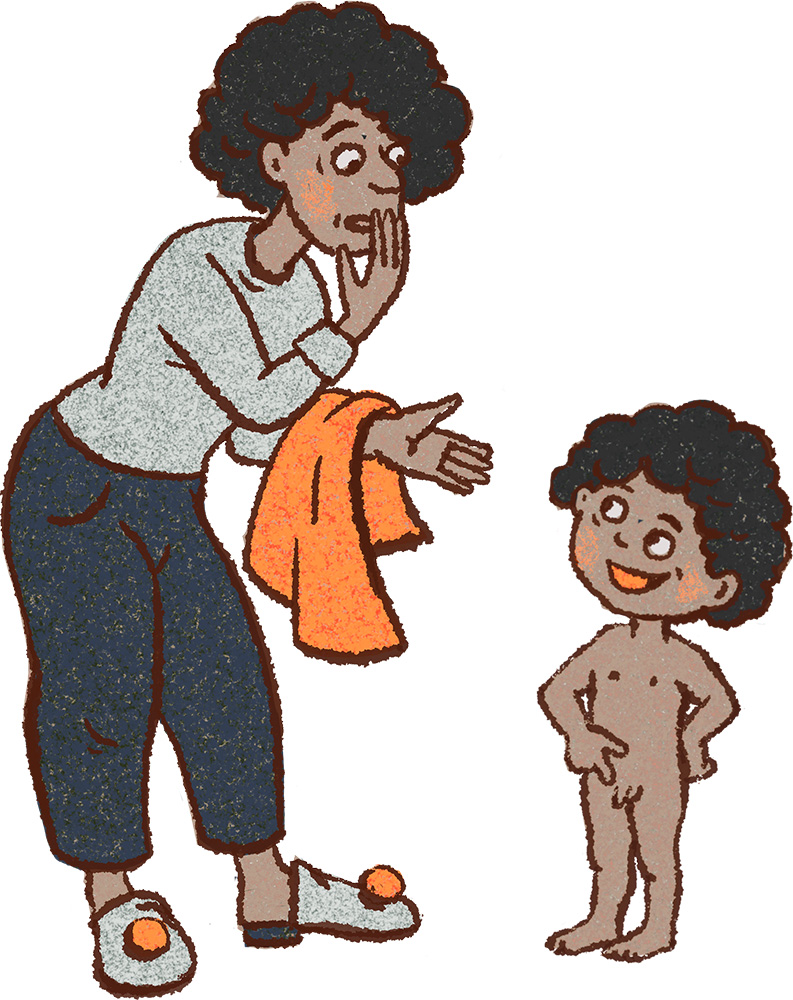
At this age, socialising with children of the same age becomes more and more relevant. Many children encounter new friends in kindergarten, on the playground or in the neighbourhood. In these groups of children, they increasingly learn how they should behave and which social rules should be observed. Most children take great pleasure in interacting with others, role plays have a special meaning. They can help to process experiences or reduce fears.
To satisfy their curiosity, children explore their own bodies or those of other children. In these games, there must be clear rules for all participants. This brings them into contact with the topic of "boundaries". Children learn to accept the limits of other children as well as to set their own.
Depending on the child, a sense of shame begins to develop at the age of three to four. It continues to develop during primary school, sometimes only shortly before puberty. As in other learning phases, the child discovers itself as an independent being. This is an important learning step. Shame is a protective function. It is used by people to defend the intimacy and privacy of their bodies. Make sure that privacy is private, but not taboo. Your child should know and be able to name their entire body. Children should also know that they are allowed to touch their own body anywhere. With an open attitude about it, your child also knows: "At home, I am allowed to ask questions - about all topics".
In their interactions with other children or in their dealings with caregivers, children learn about boundaries. This is also noticeable when children bring home words labelled as "dirty". Children notice that saying certain words triggers a certain reaction in adults. Often children do not know the meaning behind these words. The child's focus is on the reaction elicited. This is seen as funny and above all exciting. Because the question that follows is "How do you think mummy or daddy will react to this? Will I get in trouble?". To test these limits, the words are repeated and used in special situations that make the parents uncomfortable, for example in the playground.
For sexualised expressions, a three-step approach works well:
- Pronounce the word itself (this is often enough to "disenchant" the word)
- Explain the word in an age-appropriate manner
- Promote an alternative
Here you should stick to "I-messages" and put this, for example, like: "I don't like that word, find it hurtful - e.g. fuck: I would rather we say sleep with each other for that".
Children are curious
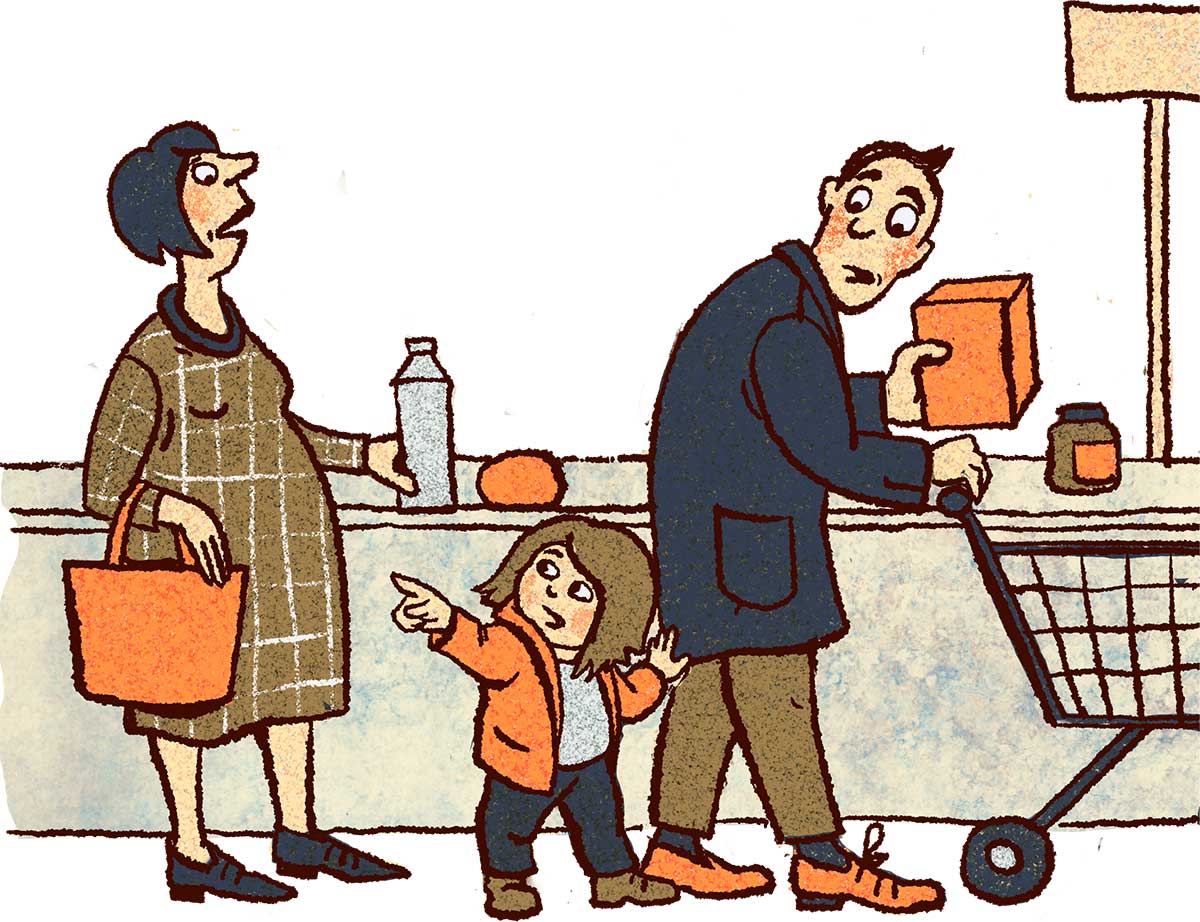
Interest in procreation is increasing among children. This can be particularly strong when, for example, a sibling is expected or a baby is growing in the belly of someone familiar to the child. Then you may be overwhelmed with questions on the subject. The child will not differentiate between questions about the body and reproduction or questions about another area of interest. Therefore, it happens that these questions are asked in possibly very awkward situations, for example when shopping at the checkout. Here it is important that you signal to the child in a loving and appreciative way that it is okay to ask all questions. You can rest assured that the answer does not have to be immediate. But come back to the question at another moment. For example, when you are at home and take time to talk with your child after putting away the groceries. You are "obliged to answer", do not wait until the child asks again - in the meantime, they might look for other sources to quench their thirst for knowledge. It is important to immediately convey the feeling to the child that "you can always ask me any questions, I will answer them for you". You should then also comply with this attitude.
Good and bad secrets
Children need the opportunity to withdraw. Your child, too, may have already enthusiastically built caves out of blankets and chairs. In the same way, the child also needs secrets. These should be secrets that do not cause harm because they are the result of violence or a threat. Beautiful and good secrets in children represent something exciting and thrilling in their life world. These promote autonomy and detachment and are important for the formation of a distinct personality. Children express their feelings differently than adults, rarely through language. Children express themselves through their behaviour, drawing pictures or in play. Therefore, it is important that you pay attention to your child's behaviour. If something seems strange to you, listen to your gut feeling and follow it up.
No means no
Children have the right and also the desire for privacy. This can be related to the body - "My body belongs to me!" This is connected to the desire to go to the toilet alone, to take a shower, to play in their own room or in the den they built themselves. As a parent, you should respect and honour this. Even if you think that your child does not clean up when taking a shower. Point this out lovingly without denying the child's own actions. It is important that you do not touch the child in any way, such as squeezing, kissing, cuddling or tickling, against the child's wishes. Instead, the child decides for itself whether it wants a hug. However, touching to avoid danger is necessary.
To develop a positive perception of the body and to encourage speaking skills, words are needed for the respective parts of the body. This gives the child the opportunity to name what it needs or does not need. Statements like "you can touch my arm, but not my belly" should be possible. This also includes the naming of the external genitals.
Children have a right to say no, even to people they trust. Saying no needs to be practised so that children can confidently defend their opinions even in emergency situations. Sentences like "I don't want that", "No, I'm not going" or "I don't like that" can be practised easily. In order to strengthen self-confidence, your child needs encouragement from you to be able to say these sentences when it feels like it. Even if you think it is inappropriate.
On the other hand, you can also appreciate the joy of how little children show off. They are proud of their bodies and feel comfortable in them. Be happy that the child is discovering its body. Gently and appreciatively guide nudity by setting rules about where and when nudity can take place. You can also make boundaries clear in a friendly way.
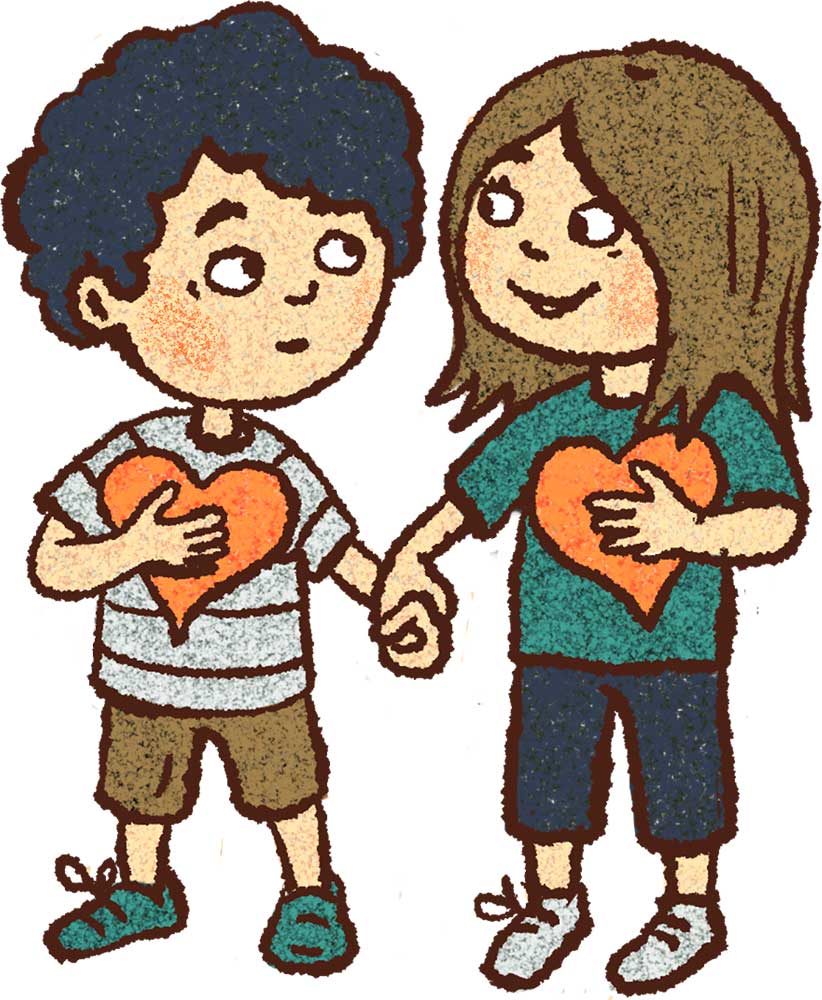
Love
Children have a unique pace of physical and psychosexual development. As parents, you will guide and support this individual development. In doing so, you should always bear in mind that child and adult sexuality must be clearly distinguished. Children have similar physical reactions as adults, but children attach a completely different meaning to these experiences: they are part of the physical experience. As parents, you should be careful not to view children's sexual acts through the lens of adult sexuality. Sexual development takes place primarily in non-sexual areas - experiences of the satisfaction of basic needs and body perception are just as much a part of this development as relationships with other people and experiences of closeness and security.
At about the age of four, children are interested in the sexes and sexual organs. They want to try out how gender roles are shaped in everyday life and in social behaviour. Parents, friends and acquaintances are role models. Through role-playing, children get in touch with each other, learn to try things out and reach their limits. They learn the rules of coexistence and can try out these rules - an important step in understanding social interaction. From about the age of four, firm friendships form, usually in groups that tend to be of the same sex. Dealing respectfully with the friendships and feelings of children at this age is an important task. When children say that they love their boyfriend or girlfriend, this should not be laughed at or played down. Not taking the nice and pleasant feelings seriously can leave confusion and disappointment. For children, the feelings of jealousy and disappointment, dreams and affection are very serious.
The cognitive development of children progresses, children no longer comprehend the world only through their bodies and senses, but with cognitive comprehension. This is evident in the fact that adults are inundated with "why" questions. It is also possible that children will not ask any questions at all. Children develop differently. As parents, you have the responsibility to initiate conversations. In doing so, you should take into account the child's limits and needs.
The conversation and the trusting feeling are more important than perfectly formulated answers. The child should be made to understand that the questions and, above all, they themselves are taken seriously and respected. This builds trust and the confidence that your child can come to you with anything and ask you. This is especially important when children experience harassment or assault. If children cannot talk about questions, experiences or observations, they will develop an aversion to speaking over time. If the child is unwell for whatever reason, they may find it difficult or impossible to communicate.
What can you do?
Questions about sexuality and reproduction often present parents with a great challenge, as they may not have the right answer immediately. The following tips can help you to educate your child:
- Do not give long lectures. Listen carefully to what your child wants to know, usually a simple answer is enough.
- Use books or other materials to help you. This will help you find the right words and your child can develop an idea of the topic being discussed.
- Be honest if you do not know or cannot explain something. Tell your child that you are thinking about it and come back to the topic later.
- Stick to the truth and be precise. Embellishments or inaccurate statements confuse children and leave you with a lot of explaining to do later.
- Ask them questions and respond to them, so that they realise that they are equal partners in the conversation and that their opinion counts.
- Use opportunities to stimulate conversation. Sentences such as "You are too small for that" or "You do not understand that" should be avoided at all costs. In this way, you convey to the child that they are not yet ready and have a negative influence on their self-confidence. Your child will then no longer come to you with questions, but will seek answers from other people or through other channels.
Exploration games
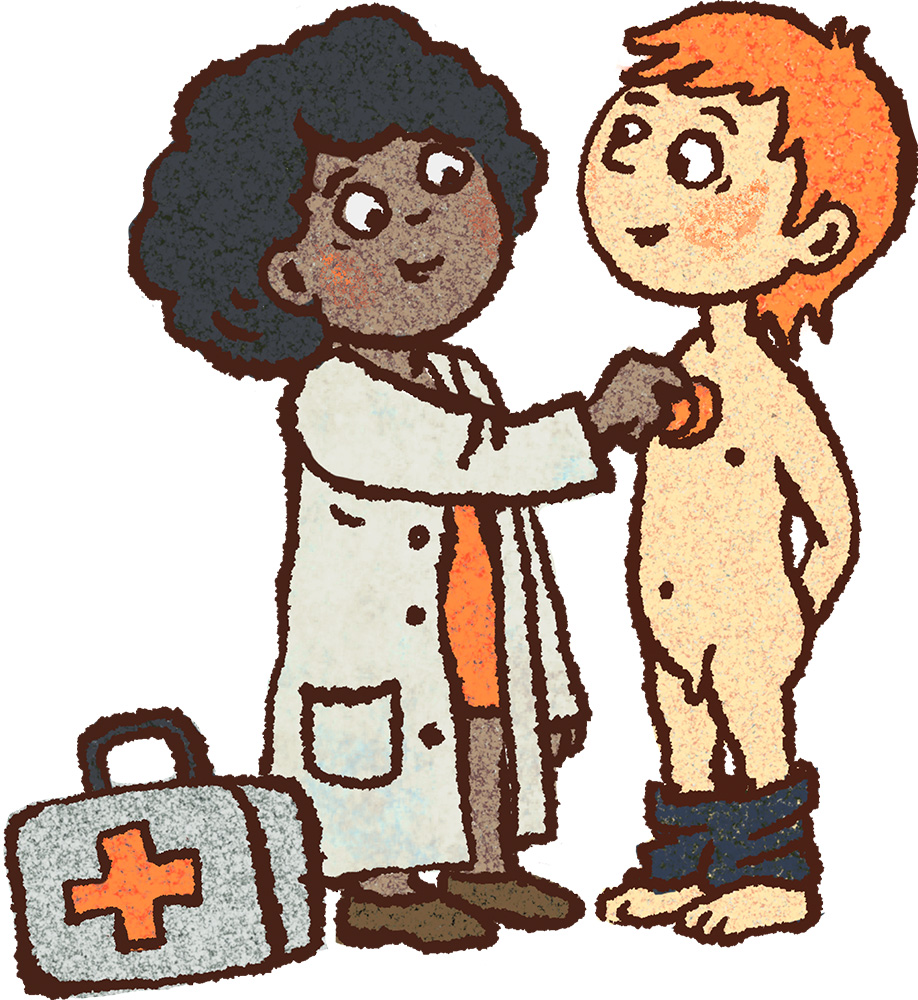
Children can pursue their curiosity about the body in exploration games, so-called doctor games. This satisfies their need for tenderness and allows them to try out different roles. For children, this is a game like other games. They try out what they have observed and find exciting. In this way, the behaviour of adults, for example kissing and cuddling or even role-playing for marriage, is imitated.
Adults' reactions can cause negative feelings of guilt or shame, so that children try to hide their doctor games. An open approach to sexuality and successful sex education enable children not to feel they have to hide anything. They can then try out experiences and fantasies in play.
It is important that the children have learned to know their own limits and to accept the limits of others. Once children have satisfied their curiosity, other games usually come to the fore again - exploration games lose their fascination.
In principle, you should allow body exploration games. You can also deliberately offer children the opportunity to play undisturbed and unobserved. As with any game, some rules should be set:
- The game is voluntary for everyone.
- No child should be persuaded or forced. Blackmail ("Then I won't be your friend any more") is also forbidden.
- No means no and everyone has to accept it.
- The game may be interrupted or stopped at any time.
- Everyone is careful with each other, nothing is allowed to hurt and nothing should be put into a body orifice.
- The children should have a similar age or power ratio, meaning approximately the same age, the same development or the same height.
Adults should only intervene if children play along against their will or are persuaded to play by older children, if the games go beyond the childish, for example putting their penis in their mouth.
Sexual assault among children
Sexual assaults can also occur among children. There are four categories: over-exuberance, unbalanced situation, deliberate assault and assault by a child who has been abused. An assault in over-exuberance is not sexual violence - but a violation of boundaries. The reason for this is often that one's own sexual interest, one's own curiosity is so strong that the boundaries of the other child are crossed. Such boundary violations can occur when playing together, for example during exploratory games. One child wants to stop or not go any further, the other child wants to go further because the situation is just so exciting - and therefore does not stop. Such situations also require adult intervention.
Pay particular attention to power and unwillingness as central features of sexual assault among children. Unwillingness seems to be an easily recognisable feature. Where sexual assaults take place with force, under loud protest or with complaints to adults, it is usually easy to recognise. However, it may also happen that children are pressured to join in a "game". During the activity, their willingness may also disappear and the activity may be continued against the child's will. A power imbalance or hierarchy between children is influenced by various factors and is usually normal. If this power imbalance is exploited to deliberately cross other children's boundaries and make resistance and rejection ineffective, adult intervention is needed.
When intervening, you should talk to the children about the rules and their motives. You should expand the children's competences and possibilities for action, for example with games on the topics of setting limits or feelings. If the exploration games take on a coercive character, this can be an indication of experienced assaults. It is also possible that children are processing an experience, for example if they have had contact with pornography or have observed sexual intercourse. Watch this more closely and seek help in counselling centres.
The rule is: the affected child takes precedence. Their right to self-determination, their feelings and perhaps their body have been violated. The child now needs to feel that he or she is not to blame. Sentences like "It takes two to tango!" or "And what did YOU do?" are inappropriate, precisely because the power imbalance was exploited. The affected child needs emotional attention and the space to express their feelings. They need to feel that they are believed. This is the only way the child can get over the incident.
The abusive child must be stopped and confronted about the behaviour. This is the only way it can learn that their power comes to an end as soon as adults intervene. They must learn that the abusive behaviour was wrong. Make sure that at the beginning of the conversation, you recount what happened just as the child concerned described it. Do not start by asking "What happened earlier?" - in most cases you will not get any clarifying answers and the child will immediately be in a denying and defensive position. Give the child who has been assaulted the space to add to or describe what happened from their point of view. Make sure that the child clearly feels that you do not doubt the credibility of the child concerned. Questions about the motivation, the why, also tend to lead to justifications, because the child usually cannot answer this question themselves. You must be clear that such behaviour is not right and must be refrained from. Make it clear that the behaviour and not the child itself is being rejected.
Sexual violence
Sexual abuse begins where contact with children is sought or continued because or even although the adult is sexually aroused by it. It is the adults who make the assessment of their own arousal - not the children. This responsibility cannot be shifted to the children, as they are often unable to assess the consequences of their actions. The task of the adults is to protect them from harmful consequences.
Early sex education is very effective in preventing sexual violence. Children who know their own bodies, are well informed, can distinguish between nice and bad feelings and have learned language about sexual content are best protected from sexual assault and can tell others or get help.
Children experience sexuality in the media

Children are confronted with depictions of eroticism and sexuality, especially outside the family, which they can perceive but not yet understand. Parents need to be media literate and talk to their children. This can help to ensure that children's experiences with sexuality, gender roles and lifestyles are not only fed by public discussion. A healthy self-confidence is the basis for warding off possible dangers.
Support your child with the following messages:
- "I am important, lovable and good the way I am." A child who is loved for who they are, not because of ability or achievement, who knows their strengths and weaknesses, can freely express their own opinion and say no.
- "I'm allowed to say no. I decide which touches I like and which I don't." Encourage your child to recognise and defend their own boundaries.
- "I know my feelings and trust them". Children should learn to know, distinguish and express their feelings.
- "I know what secrets are good and bad, talking can help and keeping silent doesn't change anything". Children should learn which secrets may be told, that getting help is a sign of strength and that there are people who will listen, believe and help them.
- "I know what we are talking about, I am allowed to ask questions and talk about everything": Enlightened children know where sexuality belongs - with big teenagers and adults. It is clear to them that sexual acts must not be done with children. They know rules and boundaries, can call a spade a spade and are not easily fooled.
Children should learn to listen to their gut feeling. They need to know that there are people who want to do them harm, for example, touch children's penises or vulvas, show children their private parts or pornographic material. Be sure to convey that your child has skills to decide who can touch them and that they can defend themselves. Most sexual assaults take place in the immediate family, so be aware of this. Therefore, children also need contact persons outside the family whom they can trust and who can provide assistance. It is the responsibility of parents and trusted persons to recognise the distress of children and to act. Seek professional and expert help through local help options and offers.
The behaviour of children who have experienced sexual violence varies greatly depending on their age and personality. Only a few children will say outright when they have experienced sexual violence, they tend to make hints because they lack the right words for what has happened. This is precisely why the hints are often not understood correctly. Be aware that children do not invent sexual abuse on their own. Some children do not notice anything, others change and show conspicuous features such as sleeping disorders, stomach aches without cause, wetting (again), language regression, fears, withdrawal or aggression, reenactment of sexual acts or sexualised language. These signs can also have other causes.

If you suspect that your child has experienced abuse, you should take this feeling seriously and follow it up.
- Find a trusted person that you can talk to.
- Show your child that they can talk to you.
- Say that you are worried because you have noticed changes.
- Stay calm and give your child permission to talk about good and bad secrets. Communicate that getting help is not tattling or a betrayal. Make your child feel that you believe him or her.
- Do not pressure your child.
- Let them know that you know about stressful situations and that you are resilient.
- Never confront the possible perpetrator.
Seek help and support from counselling centres and help lines. Determine if the kindergarten management or similar persons need to be informed.

